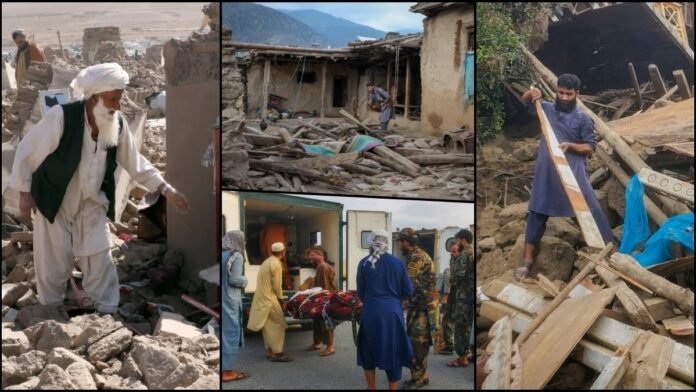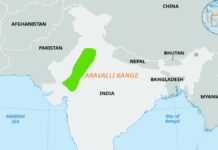
Key Points:
- 812 confirmed deaths and 2,817 injured in a 6.0-magnitude earthquake that struck eastern Afghanistan Sunday night
- Kunar and Nangarhar provinces worst affected, with entire villages “wiped out” by the shallow 8-kilometer-deep quake
- Remote mountainous terrain and landslides hampering rescue operations, forcing Taliban to deploy helicopters
- International aid flowing in: UK pledges $1.35 million, China offers disaster relief, India sends 1,000 tents and 15 tonnes of food
- Severe resource shortage at local hospitals, with Nangarhar Hospital treating 460 victims amid critical supply gaps
- UN allocates $5 million from emergency response fund as humanitarian needs escalate
New Delhi: A devastating 6.0-magnitude earthquake struck eastern Afghanistan near Jalalabad on Sunday night at 11:47 PM local time, triggering one of the country’s worst natural disasters in recent years. The shallow quake, occurring at just 8 kilometers depth, has killed at least 812 people and injured 2,817 others, according to Taliban government spokesperson Zabihullah Mujahid.
Widespread Destruction Across Eastern Provinces
The earthquake’s epicenter was located 27 kilometers east-northeast of Jalalabad, Afghanistan’s fifth-largest city in Nangarhar Province. However, the mountainous Kunar province bore the brunt of the devastation, with entire villages reported as completely destroyed.
Local resident accounts paint a horrifying picture of the disaster’s immediate impact. Sadiqullah, who was trapped under rubble for four hours, lost his wife and two sons while his father remains critically injured. The intensity was so severe that residents reported being awakened by what sounded like “a loud explosion,” followed by the collapse of house roofs across the region.
The tremors were felt as far as 140 kilometers away in Kabul and across the border in Pakistan, with several significant aftershocks following the initial quake throughout the night.
Rescue Operations Face Major Challenges
Rescue efforts are severely hampered by difficult mountainous terrain, heavy rainfall, and landslides that have blocked access roads to the most affected areas. The Taliban government has deployed helicopters for evacuation operations, with the defense ministry conducting 40 flight sorties to reach isolated communities.
Landslides have blocked the main road to the epicenter, forcing rescue teams to rely on aerial access to reach survivors trapped in remote villages. The challenging geography of the region, combined with damaged infrastructure, continues to impede the delivery of critical aid and medical supplies.
Healthcare System Overwhelmed
The earthquake has exposed the fragility of Afghanistan’s healthcare infrastructure. At Nangarhar Hospital, 460 victims have been treated, but medical staff report patients remain in severe shock with inadequate resources to handle the massive influx.
Yama Bariz from Nangarhar Hospital emphasized the critical shortage of medical supplies and personnel, stating that the hospital is struggling to cope with the overwhelming number of casualties. The shortage of doctors and essential facilities has significantly slowed rescue operations for people still trapped under debris.
Taliban health ministry spokesperson Sharafat Zaman has made urgent appeals for international assistance: “We require aid because many people have lost their lives and homes here”.
International Community Responds
Despite Afghanistan’s diplomatic isolation since the Taliban’s 2021 takeover, several countries have quickly mobilized humanitarian assistance:
United Kingdom
The UK has announced £1 million ($1.35 million) in emergency funding, distributed through UNFPA and the International Federation of Red Cross to ensure aid doesn’t reach Taliban hands directly.
India’s Swift Response
India has delivered 1,000 family tents to Kabul and 15 tonnes of food supplies to Kunar province, with External Affairs Minister S. Jaishankar confirming additional relief materials will be sent starting Tuesday. This represents one of the most substantial immediate responses to the crisis.
China and Other Nations
China has announced readiness to provide disaster relief assistance according to Afghanistan’s needs and capacity. Switzerland plans to channel aid through its humanitarian office in Kabul, while the United Arab Emirates has deployed rescue teams along with food, medical supplies, and tents.
United Nations Action
The UN has allocated $5 million from its global emergency response fund for immediate relief efforts. UN Secretary-General António Guterres confirmed that the UN mission is actively engaged in relief operations across affected areas.
Economic and Social Impact
This disaster strikes Afghanistan at a particularly vulnerable time, with humanitarian aid declining from $3.8 billion in 2022 to just $767 million in 2025. The earthquake compounds existing crises including severe drought, massive refugee returns from neighboring countries, and the Taliban government’s international isolation.
The affected region around Jalalabad serves as a crucial trade hub near the Pakistan border, making the economic disruption particularly significant for Afghanistan’s already struggling economy. The majority of structures in the area consist of low-rise mud-brick and timber homes, which are especially vulnerable to seismic activity.
Historical Context and Future Concerns
Afghanistan sits in a seismically active region and has experienced several devastating earthquakes in recent years. In October 2023, a magnitude 6.3 earthquake killed between 1,500-4,000 people (figures disputed between UN and Taliban sources). The country experienced over 1,000 earthquake-related deaths in 2022 alone.
The current disaster’s impact may worsen as rescue teams gain access to more remote areas. UNHCR spokesperson Babar Baloch warned that the scale “far exceeds the current capacity of local authorities and communities,” emphasizing the urgent need for sustained international support.
As Afghanistan continues to grapple with this humanitarian catastrophe, the international community faces the challenge of providing life-saving aid while navigating the political complexities of the Taliban-controlled government. The coming days will be critical as rescue operations race against time to reach survivors in the most isolated and devastated communities.
















































